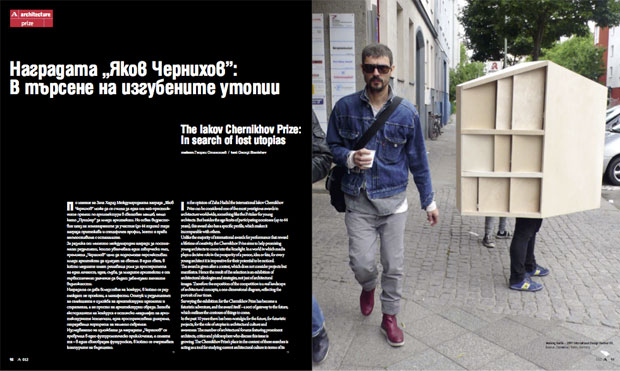Fantastic Feature in Abitare
The Bulgarian architectural magazine “Abitare” is this month dedicated to the Chernichov Prize winners. Fantastic Norway is featured on the front cover.
(From the magazine:)
“In the opinion of Zaha Hadid the international Iakov ChernikhovPrize can be considered one of the most prestigious awards in architecture worldwide, something like the Pritzker for young architects. But besides the age limits of participating nominees (up to 44 years), this award also has a specific profile, which makes it incomparable with others.
(…)
Iakov Chernikhov Prize winners for 2010 are Hakon Matre Aasarod, Erlend Blakstad Haffner, Norway, and the Fantastic Norway group. They represent an innovative strategy for the work of the architect in which his role is greatly expanded and socialized. Their approach replaces the academic and traditional model in which the investor is a firm and conductor of the assignment and formulates thetask as a result of which this architectural phenomenon was born. Fantastic Norway created a dynamic mobile studio, based in redcaravan – a travelling office that circle the country as a Rapid Reaction Corps. There, on spot in different regions of Norway and other countries in Northern Europe, the architects seek and find problems with help from local communities and municipalities, formulate their tasks, determine the investment interest, find sponsors and investors, and do their job. This activist model is new. In it there is some kind of echo from the 60s and 70s of last century and the theory of participation by Rod Hackney, Lucien Kroll, and others, which preaches the inclusion of people from the street and the user himself in the design process. But never before has the architect been so close to the demiurgic universal complexity of the future-creating individual, as in Fantastic Norway’s ideology.
In a certain sense, the strategy of the Norwegian architects meets Stefano Boeri’s, curator of the Iakov Chernikhov Prize 2010, manifesto in which he voices his concern regarding the balance between globalism and localism, poses a question to young architects how contemporary architecture can be entered in the peculiarities of local niches without provincialising them and falls into a nostalgic mood without losing the connection with global processes and trends. The top ten in the selection refers to different answers to this question, but the most vivid expression of the intensifying position of the architectural profession is recorded in the manifesto of the laureates.
You will ask where is the utopian potential: the boys are very pragmatically oriented towards solving specific local problems… Yes, but is not a utopian impulse to replace the non-existent visions of politicians, the banality of investors and the lack of ideas by the administration with active on-the-spot architectural groups?
What conclusions can we draw from the selection and winners in 2010? The activation of social and contextual reasoning in the architectural profession comes as a result of growing problems that the current political situation is increasingly less able to resolve. Hence the political and organizing mission of the architect in the world is becoming more significant. The political scene is condensed and articulated, devoid of immanent ideologies and alternative visions. The refusal of utopia restricts policy to the problems of specific pragmatism of the present. Politicians today are not able to build a decent, clear and fair picture of the future. In a world without perspective and without a single direction for development, architects are the ones who are able to compensate this absence. “The architects are starting to think politically”, believe Hakon Aasarod and Erlend Haffner, “They have to construct a much more universal outlook on life, to go beyond the perimeter of the purely spatial, formal and technological aspects of their profession”.
Summing up the situation, it seems important to emphasize that this visionary project for development of the future is one of the fundamental features of the architectural profession. The Iakov Chernikhov Prize is an attempt to explore the visionary inception’s presence in today’s architectural culture, to catalyze its development. Ultimately the role of art is not to reflect the existing world but to create alternative worlds, which in some sense are built up by different rules and laws, in other words be somewhat utopian… In this sense, the political component in the architectural design of the Norwegian group in a strange way illustrates the position of the famous German philosopher and art theorist Boris Groys, who believes that art is inherently related to policy in its manifestation and ideological aspect, since both policy and art are actually engaged in the production of manifestos and utopias… Communism, in this sense – says Groys – can be seen as a spectacular art installation and the communist manifesto – placed together with the manifestos of Dada, Futurism and Surrealism.
Today, when art and architecture are phenomena of the market system and are governed by laws of mass commercial culture and political projects appear to have stalled, society is experiencing an acute deficit of purposeful ideological projects. The architectural profession has often been a generator of utopias for spatial, but also for social structures of society, and we hope that it can catalyze a public debate on this subject today.”


Leave a Reply
Want to join the discussion?Feel free to contribute!